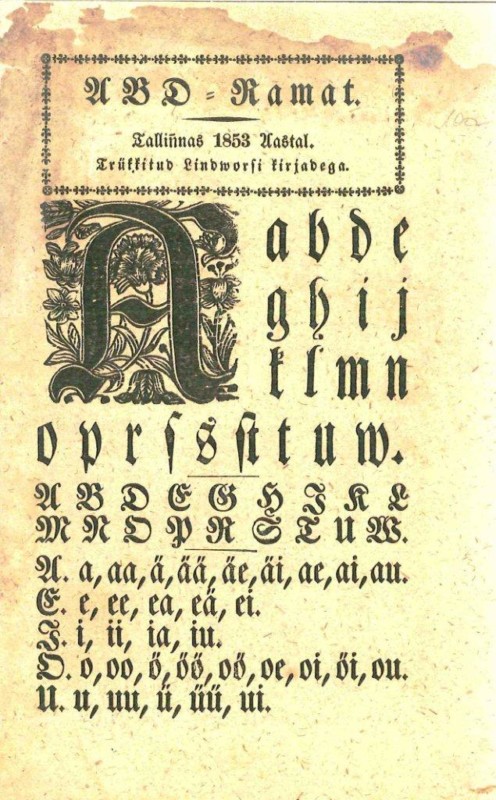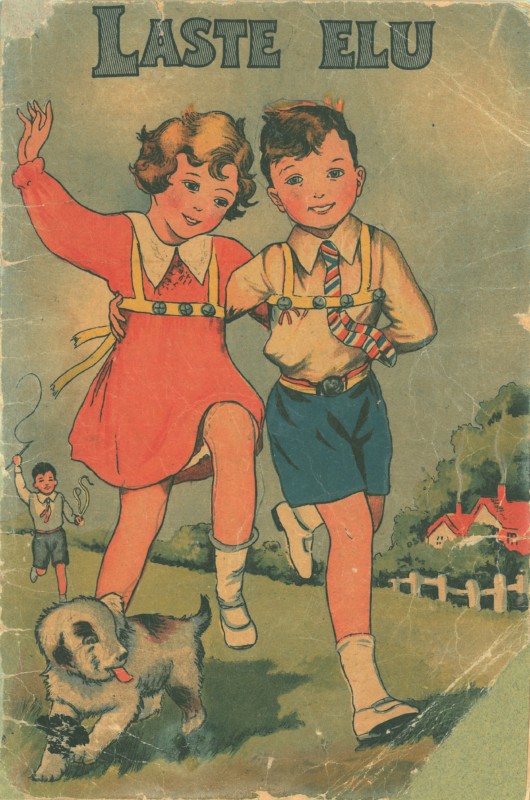There are treasures hidden in every collection. The older the collection, the more valuable and rich are its contents. A foundation was laid for piecing together the Estonian Children’s Literature Centre’s collections already more than eight decades ago – on November 12, 1933, when the Youth Library was founded at the Tallinn Central Library. The wealth of books gathered has been well kept over the long years, and even today, publications with the Tallinn Youth Library stamp can be found in our archive collection, jokingly called “our roots”. As of January 1, 2020, there were 65,536 units in the Centre’s collections. All items have been recorded in our e-catalogue, where enthusiasts can find them.
When there are a lot of books in a building and one needs to find them quickly, then some reliable system must be administered when situating the works. Thus, the base document titled “The Structure of the Estonian Children’s Literature Centre’s Collections and Guide to the Organisation of Items” exists for organising and classifying the Centre’s collections. Publications in the Centre’s fund are divided into three collections: the archive collection, the reader’s-services collection, and the information-service collection. There is additionally an art collection, to which original book illustrations belong.
Archive collection
Deposited in the archive collection are children’s books published in Estonian language and in Estonia, Estonica and a selection of foreign-language children’s literature. The criterion for the latter is the work belonging to the classics of world children’s literature, or having won a literary award. Items in the archive collection are sole copies, and are for permanent retention. Therefore, these works are subject to restricted use.
Items meant for long-term retention are lent for on-site use in the event that the reader applies for borrowing them for research- and study purposes, that there are no other copies in the Centre’s collection, and the use of the work does not damage the copy for retention. Works in the archive collection are not lent to take home. The archive collection contains smaller sub-collections: the compulsory-copy collection was established in 1998, when the Centre began receiving partial legal deposit copies under law. This means that one copy of all children’s books and children’s publications that are published in Estonia is entered into the Centre’s collection. There is also the old-book collection, where all children’s books and periodicals published before 1945 in the Centre’s possession are preserved. There are 36 rarities in the fund. These rarities are books, which were published during the years 1815–1860.
The oldest book in the Centre’s collection is “Luggemisse-Ramat hinge kassuks, maenitsusseks ning Öppetusseks”, translated by C. F. Hoffmann ja J. C. Schreiber (1815). The work is essentially a reader with religious content (including the “Our Father” with an explanation, morning- and evening prayers, and other religious texts). The Kolk Collection was formed in the autumn of 1997, when 4,000 children’s books and periodicals from the years 1820–1944 were bought from book antiquarian Tarmo Kolk. With this purchase, one of Estonia’s most complete private collections of children’s literature in the best condition reached the Centre. In honour of the collection’s former owner, the acquired copies are kept under the name “The Kolk Collection”. Two books in this collection deserve separate attention. These are “Loomade pidu” by Hendrik Laid and “Hilinenud jõulumees” by Aino Lass, which were printed on textile in the “Kuldne kodu” (“Golden Home”) series – Estonia’s first colour picture book series meant for small children. Both books were published in 1938, and were printed on both paper and calico fabric. Despite their relatively late year of publication, textile books are rare items, only lone copies of which have been preserved. The collection was expanded in 2009 with a new purchase from Mr. Kolk. A primer collection consisting of 255 books was added to the archive collection. The oldest ABC-book on our shelves is “ABD=Ramat“, published in Tallinn in 1853.
The Estonica collection contains children’s literature publications that appeared in Estonia in any language, as well as abroad in Estonian; translations of Estonian-language children’s books; and foreign-language works written by authors from Estonia.
Reader’s-services collection
The collection’s task is to satisfy the reading interests of preschool-aged children and primary-school students. The recommendations of the primary-school curriculum and the Ministry of Culture’s area-specific development schedule are followed when acquiring publications. All persons interested in children’s literature are welcome as readers, regardless of age.
The operational principles of a children’s library are followed when shaping the reader’s-services collection. A large portion of the books is available on open shelves. As the open-shelf space is limited, half of the reader’s-services collection is located in storage. The Centre avoids good books fading into oblivion by rotating them between the borrowing room and storage. Although all books are available to readers via the e-catalogue, it is pleasing foremost for younger readers to choose books right off the shelf, trusting their hand and their eyes. Books and magazines in the reader’s-services collection can be borrowed for home as well as read on site.
Information-services collection
In this collection are reference works, monographs, literature lists, and the Centre’s own publications that address children’s literature and culture as a subject area.
Children’s books and periodicals meant for children are retained permanently. Paper copies are made of periodical writings that concern the field of children’s literature but are not subject to retention, preserved as folders. This manner of retaining copies, which seems archaic at first glance, has fully justified itself in practice, and the folders are popular among information-service readers even in the Internet age.
Six foreign-language magazines on children’s literature are ordered for the information-service collection, four of which (“1000 und 1 Buch“, “Bookbird”, “Tyyris Tyllerö“, and “Children’s Literature Association Quarterly”) are Estonia’s sole copies.
Print materials in the information-service collection are lent for readers to take home. A collection of exhibition books, which brings together original children’s books with pretty pictures, has been created for organising travelling exhibitions.
Collection of illustrations
In 2006, the base was set for a collection of original illustrations from children’s books. Pictures are not purchased from all given books when expanding the collection; rather, the best examples of illustrations in books that win the “5 Best Designed Estonian Children’s Books” competition are preferred, as well as works displayed at large illustration exhibitions and personal exhibitions.
Over 300 works from 35 artists belong to the collection: Made Balbat, Katrin Ehrlich, Heiki Ernits, Mare Hunt, Kadri Ilves, Alvar Jaakson, Anu Kalm, Aleksei Kornilov, Henno Käo, Anne Linnamägi, Regina Lukk-Toompere, Ülle Meister, Tiia Mets, Jüri Mildeberg, Piret Mildeberg, Maiu Mooses, Naima Neidre, Viive Noor, Enno Ootsing, Ede Peebo, Juss Piho, Anne Pikkov, Ülo Pikkov, Piret Raud, Kristina Reineller, Tiina Reinsalu, Catherine Zarip, Tiina Tammetalu, Vive Tolli, Milvi Torim, Kelli Valk, Maarja Vannas-Raid, Asta Vender, Urmas Viik, and Silvi Väljal
Every year, some new pieces of artwork are added to the collection either as a purchase or a donation. The Centre’s new building was opened in 2008 with an exhibition of Estonian illustrators. All works displayed at the exhibition were donated to the building’s art collection. Altogether 32 artists participated in the donation, and 79 works were gifted. Despite the Centre’s modest possibilities, the works of altogether 21 artists have been purchased over the years: altogether 157 pieces.
Noteworthy donations have been made by Vive Tolli, Enno Ootsing, and Mare Hunt. The collection also has the gifted works of two foreign artists: Anita Paegle (Latvia) and Natalya Egupets (Pskov, Russia).
In 2007, Edgar Valter’s heirs decided to give to the Centre’s collection a large portion of the old master’s original illustrations that were in their possession. Thus, the Edgar Valter Collection was formed as part of the art collection, containing 2,477 original illustrations. Among them are a large number of vignettes and even a few font examples. All illustrations of the 30 children’s books illustrated by Edgar Valter belong to the collection, displayed as a selected exhibition in the Valter Gallery. In terms of pictures from the books authored by Edgar Valter (meaning both the text and the pictures are of the old master’s creation), our collection contains all illustrations from the books “Kassike ja kakuke“, “Kuidas õppida vaatama“, “Kullast vilepill“, “Metsa pühapäev“, “Pokulood“, “Pokuaabits“, “Pintselsabad“, and more. Out of the more well-known books in Estonian literature, the art collection contains the original illustrations of Edgar Valter from Ellen Niit’ “Veel ja veel Krõlliga maal ja veel” and “Suur maalritöö“, Eno Raud’s “Naksitrallid” and “Jälle need Naksitrallid“, Robert Vaidlo’s “Lood Kukeleegua linnast” and “Doktor Meerikese ja Ponts-Ontsu imepärane merereis“, as well as Aino Pervik’s “Arabella, mereröövli tütar“.
Individuals have the opportunity to order exhibitions composed of the works in the collection of illustrations for display in the event that suitable spaces are available. Publishers can use the original illustrations for publishing in print. Pieces in the collection of illustrations are not lent out to private individuals.





